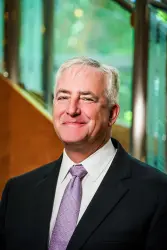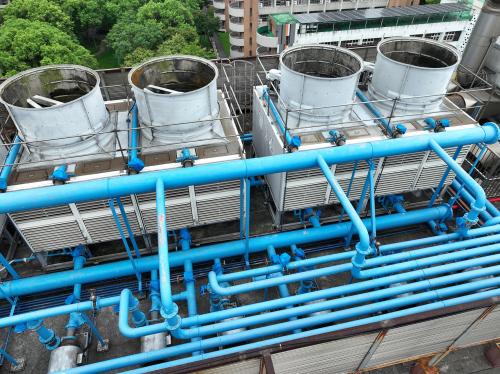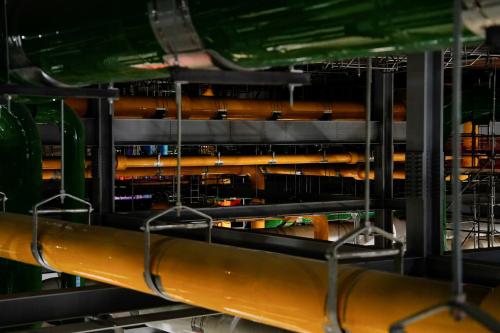As a country, we don’t invest enough in our mass transit systems, and that’s a perennial problem.
Polly Trottenberg
In this episode of Metro Blueprint, experts explore how New York City created a successful congestion pricing plan that has so far reduced traffic and increased transit ridership while retaining a bustling downtown. Adie Tomer, senior fellow at Brookings Metro, and Polly Trottenberg, former U.S. Department of Transportation deputy secretary and former commissioner of New York City’s transportation department, explain how other cities can use New York as a blueprint to implement their own congestion pricing policies.
- Listen to Metro Blueprint on Apple, Spotify, or wherever you like to get podcasts.
- Watch episodes on YouTube.
- Learn about other Brookings podcasts from the Brookings Podcast Network.
- Sign up for the podcasts newsletter for occasional updates on featured episodes and new shows.
- Send feedback email to [email protected].
Transcript
[“doors opening”; music]
PUENTES: Hi, I’m Rob Puentes, vice president and director of Brookings Metro. I’m also the host of Metro Blueprint, a podcast from the Brookings Podcast Network. Every two weeks a different Brookings Metro scholar and a guest will discuss ideas and action to create more prosperous, just, and resilient communities in America.
Results are coming in regularly from New York City’s congestion pricing plan. Launched in January 2205 and designed to reduce traffic by charging drivers a toll to enter the busiest parts of Manhattan, the early results are very promising. However, the plan faces ongoing issues with the Trump administration which has pressured the State of New York to suspend the program. While this political battle unfolds, other American cities are watching closely and considering whether New York’s congestion pricing plan could become a model for them.
In this episode of Metro Blueprint, Adie Tomer, senior fellow at Brookings Metro, and Polly Trottenberg, former deputy secretary of the U.S. Department of Transportation in the Biden administration and former commissioner of New York City’s Transportation Department, will discuss why the U.S. has struggled to crack the congestion code, why pricing roads we all use might be the breakthrough we need, and what it will take to make this politically possible in New York and beyond.
[music]
You can learn more about this podcast on our website, Brookings dot edu slash Metro Blueprint. And now, here’s Adie and Polly.
TOMER: Hi everyone, my name is Adie Tomer, senior fellow at Brookings Metro, and sitting across from me is the inimitable Polly Trottenberg. Polly, thanks for joining Metro Blueprint.
TROTTENBERG: Thanks for having me, Adie.
TOMER: I’m really excited to talk about congestion pricing today. For those who may not know, congestion pricing is actually a pretty simple concept. We want to charge motorists a fee when they enter the busiest areas of a city. In the case of New York City, that means the bridges, tunnels, and surface roads that bring people into Manhattan, south of 60th Street. Now, this is a huge deal among American economists, urbanists, and transportation professionals because the versions in other countries have all been successful. Now, with New York City over four months into its version, we’re seeing the same experience here in the U.S.
Some quick numbers before we pull you into the conversation here, Polly, to show the breadth and extent of what New York is benefiting from. There’s about 2.3 million less vehicles driving into the zone—that’s a 12% decrease. Travel speeds are up 7.5% during peak hours—that means less congestion. Buses are moving 3.2% faster and on-time performance is up, which is really important for riders. The surrounding areas didn’t get worse congestion either, which was a big concern, especially in the politics. And finally, transit ridership is up including gains over 10% for some agencies.
What does this all mean? $500 million on pace in this first year for, in particular, the MTA who runs the buses and trains in many parts of the New York metropolitan area.
So, here’s where I want to start, Polly, is rather than just how this congestion pricing system works, talk about the politics today, I actually want to start with something a little bit more visceral. One of your many hats that you’ve worn in this incredible career—and we’ve known each other for years—is actually leading New York City streets leading New York City DOT. Tell us a little about not just the kind of idea of congestion, what is congestion like in New York? How much are motorists annoyed? What is it like trying to get parking? How much are the other boroughs trying to get into Manhattan? How often would you hear from them? The New Jersey commuters, what was it like running an agency like that?
[3:36]
TROTTENBERG: It’s a great question. Before I jump into that, I want to add a few more benefits of congestion pricing:—
TOMER: —please—
TROTTENBERG: —air quality improving, noise down. People are noticing the streets are quieter and they were worried, for example, that Broadway wouldn’t be bustling. Broadway is seeing its best season ever. So even some more benefits to congestion pricing.
One thing I used to say, and I was transportation commissioner in New York City for seven years, one of the most fiercely contested things in New York is street space. For motorists, for cyclists, for pedestrians, for buses, for deliveries, for some of the other creative things the city likes to do. Restaurants, new ways of collecting trash. So it is some of the most fiercely contested real estate in the country. And when you are running those streets, 6,000 miles of streets, 800 bridges, it’s a big job.
New Yorkers let you know their opinions. And I would say interestingly enough, congestion has been a big deal in New York and particularly in the central business district in Manhattan, particularly around the bridges and tunnels. Probably one of the toughest spots that I would think of is coming into the Holland Tunnel, coming into Manhattan from the Holland Tunnel in Lower Manhattan where traffic is at a standstill for hours every single day and honking and the noise and just a lot of unhappiness about it.
And you’re trying to balance that again with all the other interests and demands that people have on the streets. And making those judgments about congestion is one challenge, but we want to make cycling safer, we want make it safer for pedestrians, we want to speed up bus travel times, and all those things are competing for in some places that very scarce street space.
I have to say, I was very lucky at New York City DOT. I had the most amazing, world-class set of engineers and planners and we worked incredibly closely on the ground with all the roadway users, including the commuters coming in, the transit agencies, the local businesses. But it’s never a job that’s done. It’s a job you’re always working to try and make better.
TOMER: Yeah, so were you just hearing about congestion all the time then? In particular, I want to paint a picture because probably most folks listening to this, you know, they’re tourists probably when they come to New York. But they do know the city. It’s not like flyover country where they’ve never been to. But locals, right? This is a headache for them, right, trying to get into that area.
[5:49]
TROTTENBERG: It’s a headache, but I want to be clear. It wasn’t only vehicle congestion; it was pedestrian congestion. And one of the great things that I started to do when I was commissioner, and the city has done more of that, is actually try and rebalance in some of those dense midtown areas right around, for example, the theater district, actually expanding sidewalk space because as much as you were seeing vehicle traffic, you’re also seeing pedestrian traffic. So you are trying to balance a lot of things on those roadways and people have a lot of opinions. And I think there was a general feeling that the system needed some improvements, and I think that did lay the groundwork for some receptivity to a big, bold experiment like congestion pricing.
TOMER: Yeah, yeah. That’s a great transition. What I want to kind of make sure folks know, this is not a new idea. This idea was effectively invented if you will in New York City arguably, right? with William Vickery at Columbia University in the 1930s or ‘40s or long enough ago that this idea has been on paper for a while, right? And it had been tried a few different times, particularly under Mayor Bloomberg, and I’m not going to get into that here. It’s a little boring of how it kind of failed in Albany, if you will.
But what I do want to start talking about is while you were in New York, how the idea starts getting ramped back up. Because I think the politics really matter here for the urbanists and economists and other folks out there who’ve looked internationally, like, we’ve got to know mechanically how to do this.
TROTTENBERG: Yes!
TOMER: The politics is where it feels like rubber meets the road, no pun intended. So take us behind the scenes while you’re there when the idea’s getting revved up. How are folks starting to come to round the table together?
[7:15]
TROTTENBERG: For sure. Actually, I want to very much contrast it to what happened in London and Stockholm because the way it went down in New York was very, very different. It was really driven in New York by the need to better support the MTA, to support the city’s mass transit system, which is, as you know, one of the most incredible mass transit systems in the country and in the world but is chronically and perpetually underfunded. And there’s always been challenges in finding new ways to get revenue sources for it.
So, the politics were driven by that and very much driven, to his credit, by Governor Cuomo, Governor Cuomo at the time seeing this as a potential way to come up with what we’re always searching for in transportation: a predictable, sustainable revenue source.
As you’re right, I think for a lot of urbanists and others, and my mayor at the time, Mayor de Blasio, agreed that this would be a great way to come up for revenues for the MTA and perhaps not have them come out of the city’s coffers, but that it would have all these other benefits. Not only raising revenue for the MTA, but reducing congestion, having environmental benefits, and roadway safety benefits. Now it’s interesting, when I talk to my counterparts in Stockholm, they took the opposite tack. They very much focused on the environmental benefits and the improved travel times for those that were driving into their central business district. They did not make a big deal about the revenue generation.
And so we took a very different approach in New York and one that I think has brought some political complexities over time. But that was really the winning coalition. The mayor and the governor they famously somewhat out of the blue, people felt, made this announcement that the city and state were going to do this together and that mayor and governor didn’t always see eye-to-eye on things. So it was a huge breakthrough. They announced kind of a key set of principles that they agreed on.
But then this had to be actualized legislatively up in Albany. And I got to spend some time up in Albany with then the chair of the MTA, Pat Foy. And it was a fascinating discussion. Obviously, the legislators in Albany, I think there was some pretty broad consensus that we needed to raise revenues for the MTA, something Albany struggles with on an annual basis. But then you had to get into a little bit of the fine-tuning. How would you handle this for low-income people, for people with disabilities? What would the geography look like? And those details got hammered out in Albany. In my time as commissioner for seven years, I did spend a lot of time up in Albany, did a lot lobbying on a lot things for the city. And I’d have to say, all things considered, to the credit of the governor and the mayor, this came together pretty quickly. When those two are in agreement, you can really move mountains. You can move mountains at the state level.
TOMER: Yeah, totally. I want to ask you about, frankly, suburban commuters. We know this is always the challenge, right? You’re basically saying, hey, you have this—I’m going to argue actually on a personal It’s a pretty nice setup, right. You got your house. You got your nice place. It can be an apartment, condo too. Sure, whatever. But you’re living outside but you’re using a different place for your work, right? And most Americans do this. And suddenly you’re saying to them, yeah, but if you want to come in this that before we were saying it’s free by car—besides, right, your gas and your tolls—we’re gonna charge you more.
What was the reception when you were working in Albany on that level, right? And obviously you all worked through it. So I think this is really fascinating because other places are also gonna have to deal with this, too, right?
[10:22]
TROTTENBERG: Yeah, and it’s really—I think they were both sort of the suburban commuters and, again, really how this would particularly impact low-income folks. They are in some case the same group, but not necessarily. And those suburban commuters or sort of outer-borough commuters—look, some of them are high-income individuals. For a certain number of people who drive into Manhattan, you’re almost by definition going to be somewhat high-income. You own a car. AAA reported as of last year, the average cost of car ownership in the United States was over $12,000 and that’s more in the New York area. A lot of those folks who commuted in were city workers, something that we tried to figure out how we would handle at the city level.
And obviously, the cost of living in New York is high. And so people did feel like, yet another way that I’m going to have to pay. And listen, I have sympathy for that. I want to acknowledge, I know we’ll talk about this more, congestion pricing is making folks pay more and for folks who are not particularly wealthy and are living paycheck by paycheck, that’s a hardship. We have to acknowledge it.
But the data was so overwhelming that this pretty small fraction of folks were more low-income who were driving into New York City on a regular basis and able to park there, versus the vast number of low-income folks that rely on the mass transit system. So I think a lot of the equity arguments did carry the day. It doesn’t mean there weren’t unhappy folks. But even in suburban areas, a lot of suburban areas—I grew up in Pelham, New York, relied upon, wasn’t called Metro North back then, but, you know, a lot suburban areas rely on having a well-funded MTA as well.
TOMER: Yeah, totally. Some of the most charming towns in America is right near those train stations.
TROTTENBERG: Absolutely.
TOMER: Right? So how much do you think it mattered in those politics that frankly those great Long Island Railroad, Metro North—the northern areas of the city, I don’t want to use too much local lexicon—that folks relied on, was that really important to help win that day? Like hey, there are alternatives here and you know this is going to come up for American context, right? I mean there are other ways to get into New York besides driving. This key in Albany when you all were talking?
TROTTENBERG: No, absolutely. I mean, look, I think a well-funded MTA benefits not just the city, it benefits the surrounding suburban areas. And I do think people recognize that.
TOMER: Yeah, yeah, that’s great. So did folks see this as a reason? I like the point you brought up that really is different than the global context from when we study it, right, of focusing on the money. Was the acute needs of the MTA kind of central then too? Like, Albany is coming to the table a little bit because this is technically their agency, right? And, like, they’ve got to find a funding fix, ideally that durable one. So you’re saying this really felt like something promising that would actually make their lives easier down the road.
[12:51]
TROTTENBERG: I think so. I do think that drove the politics. But I want to be clear too because it’s been part of, I think, some of the more recent political debate. People certainly appreciated that this would have congestion reduction benefits. And in fact, the congestion reduction benefits have been better than people anticipated. And even suburban commuters coming in from New Jersey, a lot of whom have obviously been very unhappy with this plan, some of them have conceded. It’s shortened their commutes pretty dramatically. And getting that time back every day makes a real difference.
TOMER: Yeah, totally. So maybe that’s the nice transition to where we are now. And I want to do politics in a second, but you’ve been talking a little bit about the results. But let me just ask a blunt question. Like, are you surprised by how it’s been so far? You talked about those extra benefits. Did you think it would perform this way? Is it better, the same, than what your expectations were?
[13:36]
TROTTENBERG: I mean, it’s definitely a little better than I expected. I mean I’m very familiar with what happened in London and Stockholm. So I hope that New York would see similar benefits: dollars to invest in mass transit, reduced congestion, better air quality, safer streets, all the things that I think we’re seeing in New York. So it has certainly been—I don’t know say surprising but pleasant to see that the results are kind of everything that folks had hoped for. And I think for all of us, I got to work on it in my time as commissioner, and then my time at USDOT as deputy secretary. It’s pretty gratifying to see, not just for me, but I think, for so many people who worked on this for so many years, to see it realized. It’s pretty exciting.
TOMER: Yeah. I think it’s awesome. I really want to implore listeners to go look—it’s worth a little search for it—read these personal stories of the journalists who are doing awesome work on the ground of just a business owner where, hey, it’s easier to get my deliveries. I can guarantee them, right? Those commuters who their life is a little bit quicker. You can get your kid quicker from daycare. I mean those personal stories matter.
[14:35]
TROTTENBERG: They do matter. And look, again, I want to underscore the point. It hasn’t been good for everybody everywhere. And I think, by the way, this is just a larger issue that I think in transportation and infrastructure we’re grappling with. A couple of books I’ve been interested in, Abundance by—
TOMER: –yeah, sure–
TROTTENBERG: —you know, Ezra Klein and Derek Thompson, and then Mark Dunkelman’s book, Why Nothing Works. They talk about to big important things in government and infrastructure, you’re not going to make everybody happy. And we have a pretty dismal legacy in transportation during the interstate era, where we just ran over neighborhoods literally and figuratively. And I think that really changed our confidence in letting government make big moves.
But something like congestion pricing, it’s a big move. You certainly want to minimize the impacts that cause people any harm. But to do something that big, you’re not going to get an ability to mitigate all the impacts 100 percent. And that’s something that you have to grapple with when you’re doing something big and bold.
TOMER: Yeah, this is why you do the hard work of actually reporting to people. We just get to write over here.
TROTTENBERG: And to be fair, the elected officials do the hard work. They’re the ones who really have to own some of these big, challenging projects.
TOMER: Yeah, and that’s a perfect transition to something I want to ask you about. What made big news—and those in the New York metro area who are listening they probably already know, but for the national audience—Governor Hochul, it’s pretty easy to find the news on this, delayed the program’s launch, which specifically meant it effectively switched from one federal administration to another, too.
What were your reflections on that? Less as a Biden administration official, but honestly, as someone who’s worked in this a long time, locally, federally. What did that delay mean? Did she play her cards right? And I’m not asking that in an electoral way, actually. Like, was this the right decision? Just so folks know too, she pushed for a lowering of the fee, which ended up happening. So what were your reflections on it? Because it was really big news for those of us in the space who cover it.
[16:14]
TROTTENBERG: It was, and look, I’m not going to second guess Governor Hochul. I think one interesting thing and those of us who work in infrastructure or public policy in general, one interesting thing, the folks from Sweden who did congestion pricing in Stockholm, they’ve kind of a wonderful presentation about how public opinion worked during that process and how as they were getting closer to implementing congestion pricing and Stockholm, public opinion plummeted until right at the moment before they were about to implement it. And that’s a tough moment for elected officials or transportation officials or city officials, you name it.
After congestion pricing went in in Stockholm and people saw the benefits—improved travel times, improved air quality—public opinion started to climb back up again very quickly. And in Stockholm, they actually had a requirement … it was a pilot project that they take it down and the city had to vote on whether to keep it. And even after they took it down, people voted to put it back in.
So, I’ve done some tough projects in New York myself. Fourteenth Street busway was a big one where public opinion was pretty angry. And that’s not easy. It’s not easy for elected officials, not easy for transportation officials. So, one lesson I’ve learned is you got to power through at those difficult moments. But sometimes that’s easier said than done. The good news is the governor decided in the end, she came around, it turns out, I think, the initial lower toll is generating a lot of revenue. It’s still producing very big congestion benefits, and I think perhaps it’s been a bit of a compromise. The tolls will eventually go up, I think, to where they were originally intended. So perhaps in that moment, we found a solution which is proving more durable politically and that that’s a good thing.
TOMER: Yeah, let me ask then, you know, the Stockholm example is one folks love because mostly it’s, hey, the public may not know exactly what it wants and then they see it and then you pull it away. There’s this bunch of reasons folks love it. Some of that in some ways is on the table here. So I’m going to kind of ask you a very New York-specific question here. How do you think New Yorkers might respond if they lose it? And I’m not asking in a political sense. I mean like a local, like I guess like a political economy sense, right, we’re at Brookings here so we can use that term. But do you think people would be upset if they lost it?
[18:16]
TROTTENBERG: Yes, I do. And I think it will be Stockholm-like. I think people, if for some reason it’s taken down—there’s some legal wrangles with the current administration, we’ll see how those play out—I think people will want to put it back. Part of why I think you get to that trough of public opinion is there is an understandable fear of the unknown. Those of us in transportation, this is going to be great, it’s going to produce all these benefits, and we saw what happened in Stockholm. But for your average person on the street, they may need to actually see it to see its results. And I think now in New York, we’ve seen that. And by the way, Adie, I think that’s not only exciting for New York. I talk to folks in cities all over the country, they’re looking too. It’s a proof of concept.
TOMER: I feel strongly about this. So I’m really glad you took us here. I really am because our seat at Brookings—I’m not trying to plug it I’m saying we’re watching New York but there’s amazing professionals working on this. There’s, you know this is—we’re recording this in May, so just so folks know, there’s a major legal battle happening between a mix of the State of New York, New Jersey, in some ways the city and of course the current federal administration led by President Trump and we’re not actually going to weigh in on that. That’s for the courts to decide. What I think is so interesting here is, can this be basically the idea virus? Americans love to wait to see someone else innovate first. We talk about it a lot, but no one wants to be the first mover. But once they see the results, they go. You talked to other cities’ transportation officials—
TROTTENBERG: Yeah.
TOMER: and of course you liaised with them at the federal level, right—twice. How closely do you think they’re watching this?
[19:36]
TROTTENBERG: I think they’re watching very closely. The MTA isn’t the only transit system that’s chronically underfunded. I mean, WMATA in Washington is struggling. CTA, there’s a lot of challenges in Chicago right now, not only with funding, just with the whole governance model. I mean there are transit systems all over the country. They’ve recovered in some part from COVID, but not entirely. And even before COVID, they had pretty perennial funding challenges. As a country, I will say this, we don’t invest enough in our mass transit systems, and that’s a perennial problem.
TOMER: So you think they like it on the transit side. What do you think about it as a congestion solution? I mean this is this is top of mind for everyone in transportation. Anyone who believes in the quote-unquote induced demand side of things, which you know whether that’s engineering, science, economics, it doesn’t matter—folks are saying, look, we’ve tried other interventions here in the U.S. Building more lanes is not solving congestion, I think that’s safe to say at this point. Do you think we’re looking at it from that side in those same busy cities?
[20:29]
TROTTENBERG: One hundred percent. No, and obviously the fact that some of the commuters—even commuters from New Jersey who I think have understandable reasons, they already pay big tolls to come in, they may say they’re not feeling that much in terms of benefits. But even there, I think their discounted toll—additional discounted toll is $6 and in some cases it’s saving them 30, 40 minutes a day. That’s pretty good math.
TOMER: That’s good money.
TROTTENBERG: That’s a pretty good math in our business. Not for everybody everywhere. I always want to acknowledge that. But I think for a lot of folks, if you’re already driving into New York City every day and you can save half an hour, 45 minutes on your trip, that’s more time at home with your family doing the things you want to do. So I think folks are looking at that side of it.
And roadway safety, air quality, just quality of life I think is generally improving. Not for everybody everywhere, just to be fair, but in the main, I think that’s what folks are seeing. And the opinion polls are showing public opinion is creeping up slowly but surely. I’m not going to say it’s overwhelming right now. But public opinion is improving over time. And I think that’s the other thing other communities around the country are looking at.
And remember, if you need to fund your transit system, no option’s gonna be popular. So you’re trying to find the thing that perhaps will bring other benefits and some popularity. It’s not like there’s a pain-free way to generate major revenues to fund your transit systems.
TOMER: No one can see me, but I’m shaking my head. Are you telling me there’s no free lunch in America, right? Like, I mean it’s like one of the hardest things sometimes to get across. And congestion is real pain and it’s just—I’m just pontificating myself here, feel free to respond. It’s really frustrating to see us not being willing to try new solutions, right? And this is what’s so cool about this is here’s a new solution and frankly it’s showing really good results too.
[22:04]
TROTTENBERG: A hundred percent. And that’s part of what I find so exciting about it. Again, in this era when I think, look, I’ll just be honest on the Democratic side of the aisle, again, with the books that are out sort of talking about how do we deliver better, how do we deliver faster, how do show people we can do big, bold things? I think congestion pricing is one of those things. It does show that to do something like that, you need a lot of both good political work, good technical work, good community work, and you have to be willing, I think, to accept that you’re not gonna please everybody. As someone who’s worked in transportation and particularly at the urban level in New York for many years, that’s hard. It’s just hard to do. But when you do something big, the results are big.
TOMER: By the way, just so everyone understands again what we’re talking about. In four months, you’re seeing results that just folks in transportation would be killing for over, maybe even four years. So this is really dramatic impacts. Let me ask two last questions. The first one is, okay, what are the lessons? Let’s imagine there’s some urban and metropolitan mayors listening to this, right? Back to kind of where we started in some ways, what would be your advice for them? How do you make sure your coalitions are ready in advance? How do you get in front of some of the kind of political communication elements, right? with the public and making sure they understand what the trade-offs here that you’re bringing up? How do you set the table for a program like this to be successful somewhere else?
[23:19]
TROTTENBERG: Yeah. I mean, look, I think at least in transportation and not just transportation across a lot of public policy fields, bold leadership is a key ingredient. In this case, it was led by Governor Cuomo. Mayor de Blasio jumped on board. I mean, in New York, when a mayor and a governor come together on something big like this, that really—as I said—that moves mountains. So I think you need that grassroots support. You need local support and activist support. But you need real political leadership.
And look, I think that real political leadership can yield some big political results. So I would advise to those that are looking at it, it really can be worth doing but you have to be bold and lead and have to ready to I think deal with the fights, the objections, the concerns best you can.
I do think the coalition of advocacy is very important and in the case of congestion pricing in New York, transit advocates, roadway safety advocates, environmental advocates, and as you say, sort of urbanists and just people in transportation who followed this issue for a long time. And then also some of the folks who are really economically minded. And that actually I think was even a bigger deal in London and Stockholm, people who really made the economic arguments. This is a scarce resource, roadway space. And if we want to use it efficiently, we have to price it better.
TOMER: Yeah, that’s great. And I think those are easy lessons. Let me make this the final question is the hardest one—prediction time. Let’s call it the next five years, or you could say ten if you want some more time. Do you think other big cities, big metro areas might adopt this now?
[24:46]
TROTTENBERG: I do. I mean, look, clearly we have an administration right now that doesn’t seem inclined to be supportive of congestion pricing, so I don’t know if anything will happen in the next few years. But, one thing I know in New York, this doesn’t happen overnight. It took, as you mentioned, this started back with Mayor Bloomberg. It can take a long time, I think, for the politics to gel because probably in most cases you’re going to need to have your city politics and your state politics.
So here’s a good time to lay the groundwork. And certainly in New York, in addition to the politics, just the technical work that New York City DOT did with the MTA. Doing all the analysis on the streets, finding the right equipment, how you’re going to install the cameras, what the back office fare collection piece was going to be. So there’s actually a lot of technical work that goes into this as well.
And then the deep environmental work that the city and the state had to do together that was overseen basically by the Federal Highway Administration during the Biden administration.
So there’s a lot of work! And you can certainly get started on that. And it probably, at the very least, can take a few years. So this is a good time perhaps to lay some of the groundwork if it’s something a city or state is thinking of doing in five, 10 years.
TOMER: Yeah. I love that. I’m positive too. Polly Trottenberg, thanks for coming by.
TROTTENBERG: Thanks, Adie. Thanks for having me.
TOMER: Yeah, and thanks everyone for listening.
[music]
You can find more of our work at Brookings dot edu slash Metro, and if you want our information to come right into your inbox, you can sign up for newsletters at Brookings dot edu slash newsletters. Thanks.
PUENTES: Metro Blueprint is a production of the Brookings Podcast Network, found online at Brookings dot edu slash podcasts. Thank you for listening.
My thanks also to all the scholars and guests for sharing their insights and expertise, and to the team at Brookings that makes this podcast possible including Fred Dews, producer; Erin Raftery, associate producer; Gastón Reboredo, audio engineer; Daniel Morales, video editor; Leigh Balon, Brookings Metro’s director of communications; Carie Muscatello, our graphic design and web publishing manager; as well as our government affairs and promotion colleagues in the Office of Communications. Katie Merris designed the beautiful logo, and Phoebe Copeland recorded the doors audio.
For more information about us, please visit Brookings dot edu slash Metro.
I’m Robert Puentes.
[“doors closing”]
The Brookings Institution is committed to quality, independence, and impact.
We are supported by a diverse array of funders. In line with our values and policies, each Brookings publication represents the sole views of its author(s).








Commentary
PodcastWill New York’s congestion pricing program pave the way for broader adoption?
Listen on
Metro Blueprint
June 4, 2025